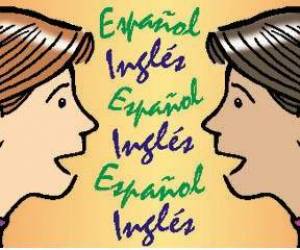1. CODE-SWITCHING
The use of Code-Switching is sometimes thought to be a
broken way of speaking by mixing two languages, in this case, Spanish and
English. It can also be interpreted as a lack of language ability. And even
though this might be true, there are other reasons why this phenomenon happens.
For example, Code-Switching can prove that the speaker has knowledge of both
languages and is capable of switching from one and the other making sense in
what they are saying.
According to O. A. Santa Ana (1993), the bilingual
speakers are not a homogeneous group; native Spanish speakers’ knowledge of
English ranges from passive to full competence.
Crystal
(1987) suggests that code, or language, switching occurs when an individual who
is bilingual alternates between two languages during his/her speech with
another bilingual person. A person who is bilingual may be said to be one who
is able to communicate, to varying extents, in a second language. This includes
those who make irregular use of a second language, are able to use a second
language but have not for some time (dormant bilingualism) or those who have
considerable skill in a second language.
We refer to Code-Switching when the speaker forms
complete sentences in both Spanish and English. For example, “Yo no estoy de
acuerdo con eso. But, anyhow, I think I will try again to get it.”
Spanglish is not so different from Code-Switching. In
this case, instead of forming sentences in different languages, the speaker
just adds a word to what they are saying.
It is very common to see this phenomenon happen in
Americans whose parents speak Spanish. They will speak English in their school
or with their friends but at home they can sometimes mix the languages.
3. SURVEYS ABOUT
CODE-SWITCHING AND SPANGLISH
We made 30 surveys to some UANL students of different faculties to verify
our hypothesis. We asked three questions in Spanish because we wanted to make
sure that everyone understood the questions.
The first
question is: What linguistic phenomenon do you use more? Twenty eight students
chose the option “Spanglish,” and two students chose Code-Switching.
The second
question is: Why do you use it? Nine students chose the first option “To
distinguish what I want to say,” fifteen students chose the second option “When
you forget the word in Spanish and you say it in English,” and six students
chose the last option that is: another one, they wrote: because they want to
practice more the English language; it sounds good, they said by instinct and
habitually.
And finally,
the third question is: With who do you use it? Twenty six students chose the
option “with friends” (one of them chose also with the family), two students
(including the other person) chose the option “with family,” and three students
chose “with everybody.”
CONCLUSION
After our investigation we realized that there is very little difference
between Code-Switching and Spanglish. The first one forms complete sentences in
both English and Spanish while the other
one includes a single word in the
opposite language.
The most used phenomenon in
UANL students is Spanglish. We agree with them as we use this phenomenon a lot too.
The answers didn’t really change from the different faculties. Code-Switching
is used too but in a lower level.
REFERENCES
Crystal,
D. (1987). The Cambridge Encyclopedia of Language. Cambridge University Press:
Cambridge.
O. A. Santa Ana. 1993. “Chicano English and the Nature of the Chicano Language
Setting, Hispanic Journal of Behavioral Sciences 15(1):3-35.





No hay comentarios.:
Publicar un comentario